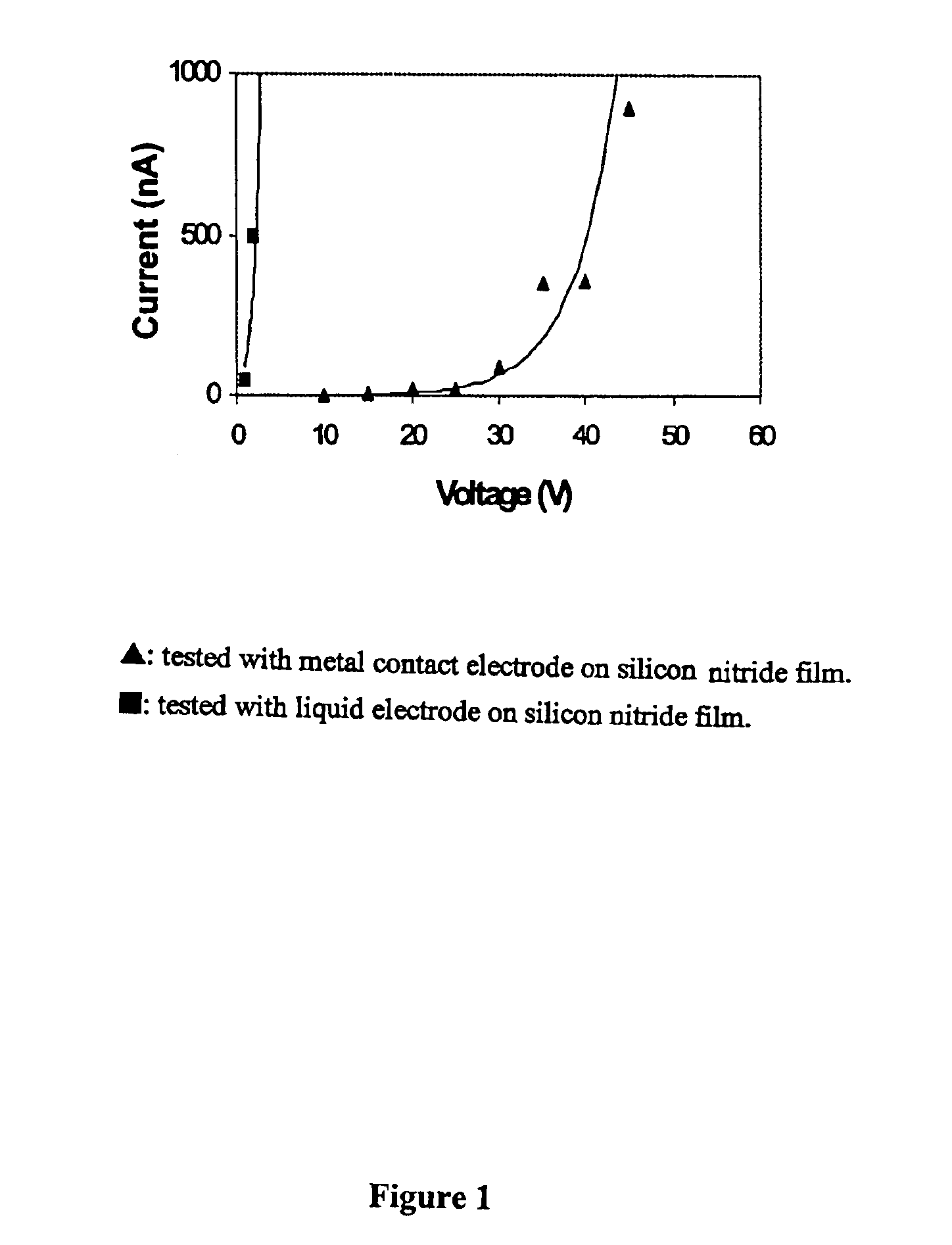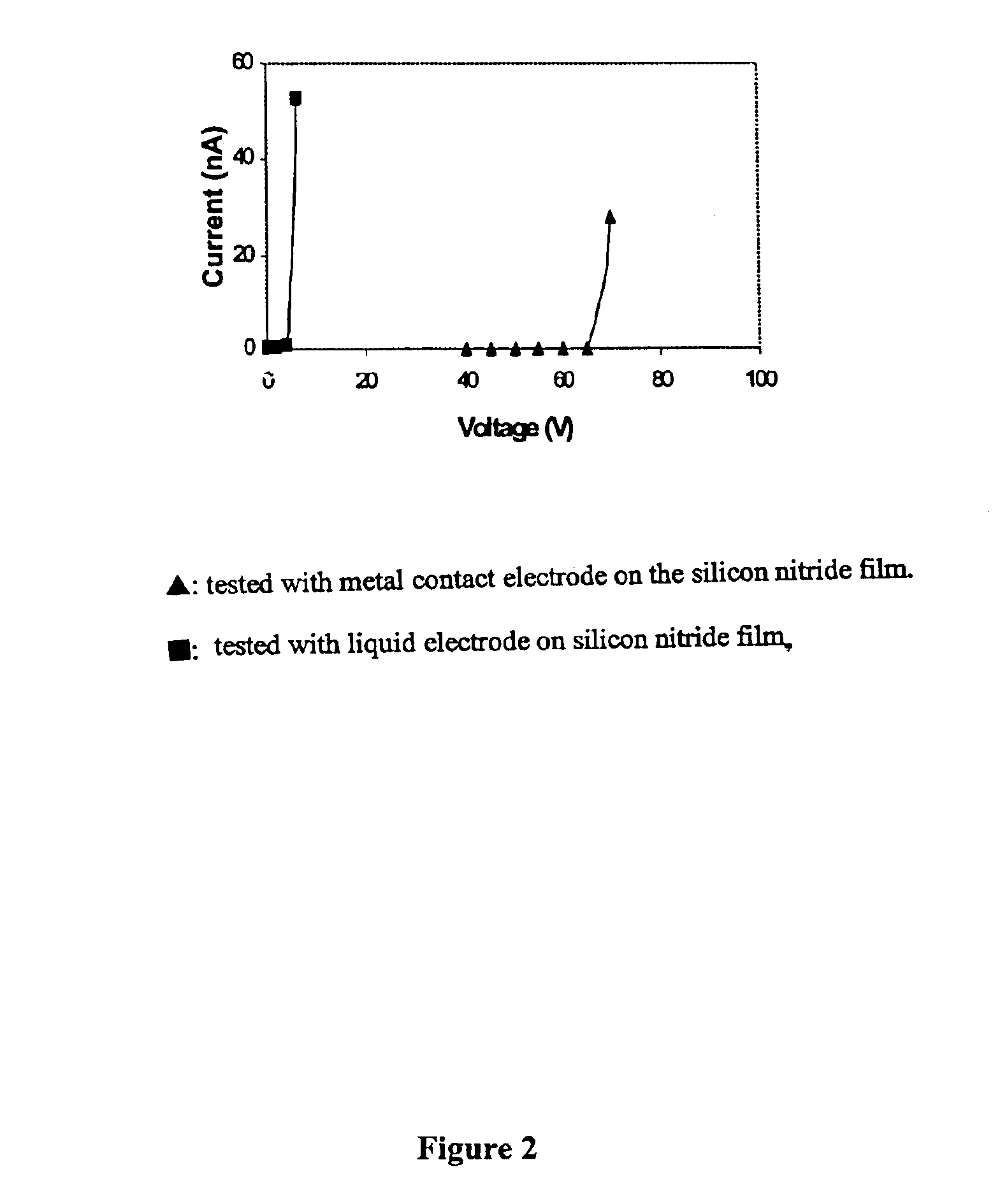Dielectric film
a technology of dielectric film and film, applied in the field of dielectric film, can solve the problems of constant decrease of amount, inability to implement integrated electronics or electric fields in the early system, and short supply of sample quantities and volumes
- Summary
- Abstract
- Description
- Claims
- Application Information
AI Technical Summary
Benefits of technology
Problems solved by technology
Method used
Image
Examples
example 1
[0053]Data for FIG. 1 was generated using the following experimental setup and conditions. A silicon wafer was cleaned using semiconductor cleaning protocols (MOS clean). 100 nm low stress nitride was deposited on a silicon wafer in a low-pressure chemical vapor deposition oven. The sample was then cleaved and placed in an electrical test apparatus for assessment of the dielectric breakdown strength of the thin film. Conductive epoxy was used to make good electrical contact between the silicon substrate (cleaved edge of the wafer) and the grounded metal stage. Positive (or negative) voltage was applied under dry conditions using a metal electrode, or under wet conditions, utilizing a fluid electrode. The voltage was ramped up in a stepwise fashion while simultaneously monitoring the current leaking through the film to the silicon substrate. The curve was recorded and the data can be seen in FIG. 1. It is seen from this data that the current—voltage characteristics of the low stress ...
example 2
[0054]Data for FIG. 2 was generated using the following experimental setup and conditions. A silicon wafer was cleaned using semiconductor cleaning protocols (MOS clean). 100nm of high stress nitride was deposited on a silicon wafer in a low-pressure chemical vapor deposition oven. The sample was then cleaved and placed in an electrical test apparatus for assessment of the dielectric breakdown strength of the thin film. Conductive epoxy was used to make good electrical contact between the silicon substrate (cleaved edge of the wafer) and the grounded metal stage. Positive (or negative) voltage was applied under dry conditions using a metal electrode, or under wet conditions, utilizing a fluid electrode. The voltage was ramped up in a stepwise fashion while simultaneously monitoring the current leaking through the film to the silicon substrate. The curve was recorded and the data can be seen in FIG. 2. It is seen from this data that the nitride film has much less dielectric strength ...
example 3
[0055]Data for FIG. 3 was generated using the following experimental setup and conditions. A silicon wafer was cleaned using semiconductor cleaning protocols (MOS clean). 1.5 μm of low stress nitride was deposited on a silicon wafer in a low-pressure chemical vapor deposition oven. The wafer was then cleaved and one pieces was preserved for electrical testing with only the low stress nitride and another piece was further processed with the addition of a subsequent deposition of 100 nm of oxynitride. The samples were then cleaved and placed in an electrical test apparatus for assessment of the dielectric breakdown strength of the thin film. Conductive epoxy was used to make good electrical contact between the silicon substrates (cleaved edges of the wafer) and the grounded metal stage. Positive (or negative) voltage was applied under dry conditions using a metal electrode, or under wet conditions, utilizing a fluid electrode for both samples. The voltage was ramped up in a stepwise f...
PUM
| Property | Measurement | Unit |
|---|---|---|
| size | aaaaa | aaaaa |
| thick | aaaaa | aaaaa |
| dielectric strength | aaaaa | aaaaa |
Abstract
Description
Claims
Application Information
 Login to View More
Login to View More - R&D
- Intellectual Property
- Life Sciences
- Materials
- Tech Scout
- Unparalleled Data Quality
- Higher Quality Content
- 60% Fewer Hallucinations
Browse by: Latest US Patents, China's latest patents, Technical Efficacy Thesaurus, Application Domain, Technology Topic, Popular Technical Reports.
© 2025 PatSnap. All rights reserved.Legal|Privacy policy|Modern Slavery Act Transparency Statement|Sitemap|About US| Contact US: help@patsnap.com



